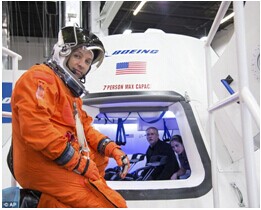
Boeing is planning to develop a so-called space taxi for NASA astronauts. It includes a seat for paying tourists to fly to the International Space Station. The $4.2 billion, five-year contract allows Boeing to sell rides to tourists.
Although the exact price has not been set, Boeing said that the price would be competitive with what the Russian space agency now charges to fly tourists to the orbital outpost(轨道前哨)- around $50m.
“Part of our proposal into NASA would be flying a Space Adventures spaceflight participant up to the ISS,” Boeing said. Space Adventures is scheduled(计划)in January to begin training British singer Sarah Brightman for a 10-day visit to the station, a trip costing $52 million. Brightman hopes to become the eighth paying passenger to travel to the station, a $100 billion research complex that flies about 260 miles (418 km) above Earth. Boeing’s first test launch of the taxi is not expected until 2017.
But Boeing faces competition from rival Space Exploration Technologies, or SpaceX, which also won a NASA contract and says it can develop the taxi for nearly 40 percent less than Boeing. SpaceX already plans to offer trips to tourists, but did not immediately respond to questions about whether it would fly tourists on its NASA missions.
The taxi project appears to be well within Boeing’s core space capabilities, which suggests it will not have trouble meeting its cost and schedule targets.
Separately, Boeing and Lockheed announced recently that United Launch Alliance(同盟)would invest heavily in a new rocket engine being developed by Amazon.com founder Jeff Bezos and his private company space company Blue Origin. The agreement is aimed at freeing the
本时文内容由奇速英语国际教育研究院原创编写,禁止复制和任何商业用途,版权所有,侵权必究!
1.What is discussed in the passage?
A The space taxi allows Boeing to sell seat to tourists.
B Boeing reveals to develop a space taxi for astronauts.
C A space taxi will be built to send tourists to the orbit.
D Boeing and Space X will build the space taxi together.
解析:选B。B 主旨大意题。文章首句为主题句,概括了本文要介绍的内容:波音公司计划打造“太空的士”。除运送宇航员之外,还有太空旅游计划。
2.What is the advantage of Boeing in developing the space taxi?
A It can fly tourists on its NASA missions.
B It spends 60 percent of the Space X to finish the contract.
C Lockheed promised to help Boeing with the project.
D The project works well within its core space capabilities.
解析:选D。D 细节理解题。根据文章第五段…appears to be well within Boeing’s core space capabilities, which suggests it will not have trouble meeting its cost and schedule targets可知,波音公司具备核心空间能力,因此将非常顺利地完成“太空的士”任务。
3.What can be implied in the passage?
A Tourists will have more choices for space trips.
B Boeing can build better space taxi than its rival.
C Brightman is one of the wealthiest singers in the world.
D Russian space agency charges a tourist too much.
解析:选A。A 推理判断题。根据文章第三段可知,波音公司与太空探索科技公司都与国家宇航局签订了制造“太空的士”的合同,这意味着将来游客到太空旅行有更多的选择。
4.Why would the United Launch Alliance invest heavily in a new rocket engine?
A The alliance wanted to promote commercial satellite launches.
B The alliance tried to help the US gain independence in making rocket engines.
C The alliance hoped to help Boeing and Lockheed to build the new space taxi.
D The alliance intended to reduce the Russian effect of rocket engine to the least.
解析:选B。B 细节理解题。根据文章最后一段…aimed at freeing the United States from its dependency on Russian-made engines for rockets for launches…可知,联合发射联盟斥巨资的目的在于使美国摆脱对于俄罗斯生产的火箭发动机的依赖。故选B。
5.Which column of a newspaper do you think this article belong to?
A Business.
B Travel.
C Technology.
D Entertainment.
解析:选C。C 推理判断题。本文介绍了太空的士计划,为科学技术题材,属于“技术”栏目,故选C项。